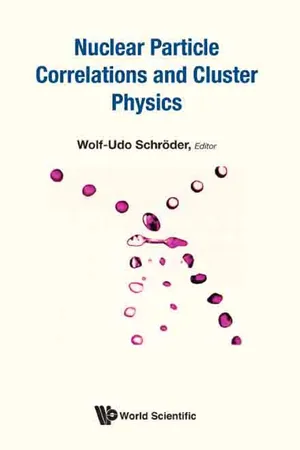
- 572 pages
- English
- ePUB (mobile friendly)
- Available on iOS & Android
Nuclear Particle Correlations and Cluster Physics
About This Book
-->
A timely presentation of new results, challenges, and opportunities in the quickly developing field of nuclear cluster physics, presented by an international group of eminent theoretical and experimental scientists active in the field. Their work reveals how correlations of nucleons can appear spontaneously, propagate, and survive in nuclear matter at both low and high densities. Characteristic nuclear substructures, beyond those predicted by mean-field or collective scenarios, appear on microscopic and cosmic length scales. They can influence the dynamics of fusion of light nuclei and the decay of heavy, fissioning nuclei or of systems produced transiently in heavy-ion reactions. A must-read for young scientists entering the field and a valuable resource for more seasoned nuclear researchers!
--> Contents:
- General Cluster Properties:
- Similarities and Differences Between Nuclear and Metal Clusters (P M Dinh, P-G Reinhard and E Suraud)
- Particle Correlations in Dilute and Dense Matter:
- Correlations and Clustering in Dilute Matter (G Röpke)
- Nuclear Clustering in Fermionic Molecular Dynamics (H Feldmeier and T Neff)
- Comparison of Equation of State Models with Different Cluster Dissolution Mechanisms (H Pais and S Typel)
- Clustering and Pasta Phases in Nuclear Density Functional Theory (B Schuetrumpf, C Zhang and W Nazarewicz)
- Fragmentation of Neutron Star Matter (P N Alcain and C O Dorso)
- General Cluster Properties:
- Clustering in Stable and Exotic Light Nuclei (C Beck)
- Clusters in Astrophysics (M Wiescher and T Ahn)
- Persistence of Clustering at High Excitation Energy: Clues from 24 Mg (F Gulminelli, L Morelli, M Bruno, M D'Agostino and G Baiocco)
- Particle-Particle Correlations: A Tool for Investigating Excited States and Clustering Effects in the Decay of Excited Nuclei (L Morelli, M Bruno, M D'Agostino, G Baiocco, F Gulminelli, T Marchi and S Barlini)
- Cluster Radioactivity/Fission and SHE:
- Nuclear Size Isomers: The Excited States of Light Nuclei with Cluster Structure and Nonstandard Sizes (A A Ogloblin, A N Danilov, A S Demyanova, S A Goncharov, T L Belyaeva and W Trzaska)
- Manifestations of Clustering in Binary and Ternary Fission of Low Excited Heavy Nuclei (Yu V Pyatkov and D V Kamanin)
- Spontaneous Fission, Cluster Radioactivity and Alpha Decay of Superheavy Nuclei 282,284 Cn and 286 Lv (D N Poenaru and R A Gherghescu)
- Predictions on the Feasible Alpha and Cluster Decays from 298–336 126 Superheavy Nuclei (K P Santhosh and B Priyanka)
- Cluster Effects in Nuclear Reactions:
- Mean-Field Instabilities and Cluster Formation in Nuclear Reactions (M Colonna, P Napolitano and V Baran)
- Clusters in Heavy-Ion Collision Dynamics (A Ono)
- Molecular Structures in Slow Nuclear Collisions (A Diaz-Torres)
- Dynamical Collective Clusterization in Hot and Rotating or Non-Rotating Compound Nuclei Including Spontaneous Cluster Radioactivity (R K Gupta)
- Multifragmentation in the Perspectives of Various Clusterization Algorithms (R Kumar, A Sharma, S Sood and R K Puri)
- Using Fast Processes to Investigate Cluster States and Nuclear Correlations in Medium-Heavy Nuclei: Specific Tools and New Opportunities with Radioactive Ion Beams (T Marchi, F Gramegna, L Morelli, S Barlini, D Fabris, V L Kravchuk and O V Fotina)
- "Necklace" Cluster Fragmentation of the Dinuclear System in Dissipative Reactions (S O Nyibule, M J Quinlan, E Henry, H Singh, I Pawelczak, J Tõke, W U Schröder, L Auditore, G Cardella, M B Chatterjee, E De Filippo, G Lanzalone, C Maiolino, A Pagano, M Papa, S Pirrone, G Politi, F Rizzo, P Russotto, A Trifiro and G Verde)
-->
--> Readership: Researchers and graduate students in nuclear, high energy and particle physics. -->
Frequently asked questions
Information
Part 1
General Cluster Properties
CHAPTER 1
SIMILARITIES AND DIFFERENCES BETWEEN NUCLEI AND METAL CLUSTERS
1.Introduction
2.Basic properties: nuclei versus metal clusters
2.1.Orders of magnitudes and scales
Table of contents
- Cover Page
- Title
- Copyright
- Preface
- Contents
- Part 1. General Cluster Properties
- Part 2. Particle Correlations in Dilute and Dense Matter
- Part 3. General Cluster Properties
- Part 4. Cluster Radioactivity/Fission and SHE
- Part 5. Cluster Effects in Nuclear Reactions
- Index